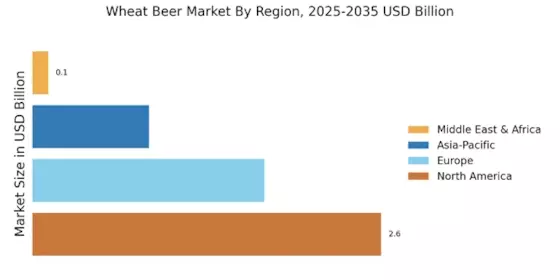Flavor Innovation
Flavor innovation plays a crucial role in the Wheat Beer Market, as breweries experiment with various ingredients to create distinctive offerings. The incorporation of fruits, spices, and herbs into wheat beers has led to a diversification of flavors, appealing to a wider audience. This trend is supported by market data indicating that consumers are increasingly interested in trying new and exotic flavors. As the industry evolves, the ability to innovate and adapt to changing consumer preferences will be essential for breweries aiming to capture market share. The Wheat Beer Market stands to benefit from this focus on flavor innovation, as it encourages exploration and enhances the overall consumer experience.
Craft Beer Popularity
The Wheat Beer Market is experiencing a notable surge in popularity, primarily driven by the craft beer movement. Consumers are increasingly seeking unique and artisanal beverages, leading to a rise in demand for wheat beers, which are often characterized by their refreshing taste and diverse flavor profiles. According to recent data, craft beer sales have shown a steady increase, with wheat beers capturing a significant share of this market. This trend is further supported by the proliferation of microbreweries and brewpubs, which are introducing innovative wheat beer varieties. As consumers become more adventurous in their drinking habits, the Wheat Beer Market is likely to benefit from this growing inclination towards craft and specialty beers.
Health-Conscious Choices
In recent years, there has been a marked shift towards health-conscious choices among consumers, which has positively impacted the Wheat Beer Market. Wheat beers, often perceived as lighter and less caloric than traditional lagers, appeal to individuals seeking healthier alternatives. The industry has responded by developing wheat beers with lower alcohol content and fewer calories, catering to this demographic. Market data indicates that the demand for low-calorie and low-alcohol beverages is on the rise, suggesting that wheat beers could capture a larger segment of health-oriented consumers. This trend reflects a broader movement towards mindful drinking, where consumers prioritize quality and health benefits, thereby enhancing the Wheat Beer Market's growth prospects.
Sustainability Initiatives
Sustainability initiatives are becoming increasingly relevant within the Wheat Beer Market, as consumers show a growing preference for environmentally friendly products. Breweries are adopting sustainable practices, such as sourcing local ingredients and implementing eco-friendly packaging solutions. This shift not only appeals to environmentally conscious consumers but also aligns with broader societal trends towards sustainability. Market analysis reveals that brands emphasizing their commitment to sustainability are likely to attract a loyal customer base. As the Wheat Beer Market continues to evolve, the integration of sustainable practices may serve as a key differentiator, potentially enhancing brand reputation and consumer trust.
Increased Distribution Channels
The expansion of distribution channels is significantly influencing the Wheat Beer Market, as breweries seek to reach a broader audience. The rise of e-commerce and online retail platforms has made it easier for consumers to access a variety of wheat beers from different regions. Additionally, partnerships with restaurants, bars, and retail outlets are enhancing the visibility of wheat beer brands. Market data suggests that increased distribution not only boosts sales but also fosters brand loyalty among consumers. As the Wheat Beer Market continues to grow, the ability to effectively navigate and leverage these distribution channels will be vital for breweries aiming to maximize their market presence.


















Leave a Comment